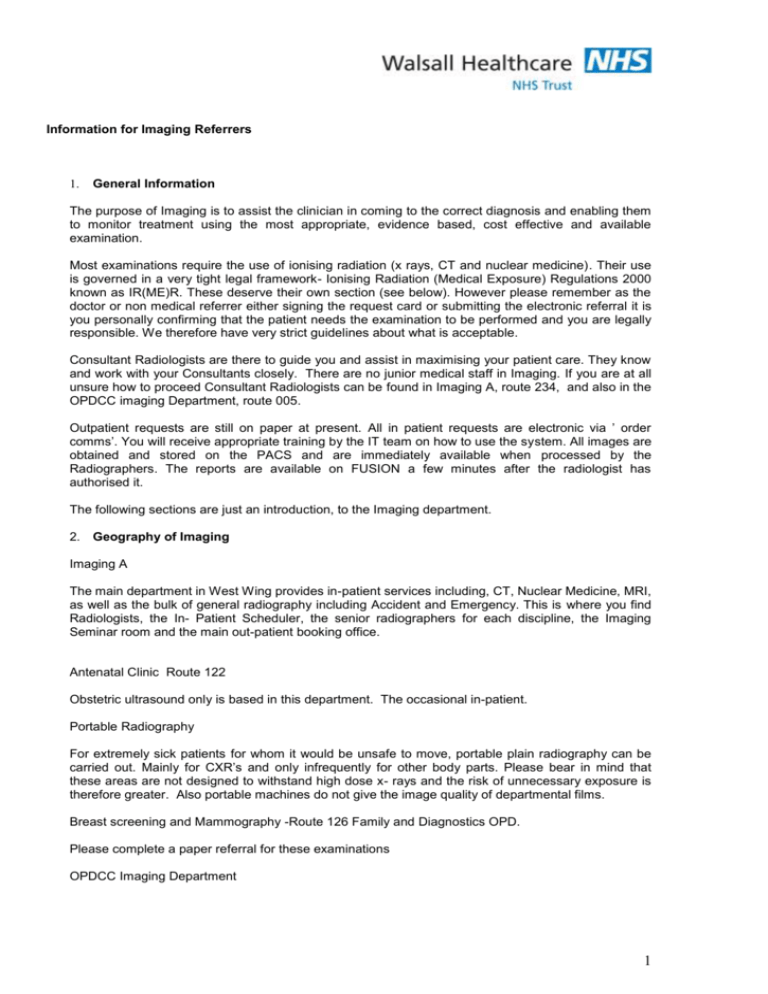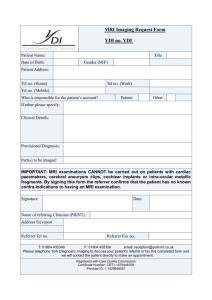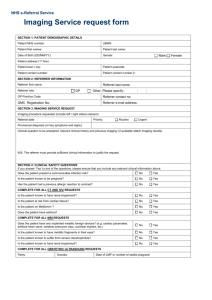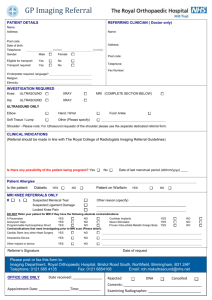Imaging A - Walsall NHS
advertisement

Information for Imaging Referrers 1. General Information The purpose of Imaging is to assist the clinician in coming to the correct diagnosis and enabling them to monitor treatment using the most appropriate, evidence based, cost effective and available examination. Most examinations require the use of ionising radiation (x rays, CT and nuclear medicine). Their use is governed in a very tight legal framework- Ionising Radiation (Medical Exposure) Regulations 2000 known as IR(ME)R. These deserve their own section (see below). However please remember as the doctor or non medical referrer either signing the request card or submitting the electronic referral it is you personally confirming that the patient needs the examination to be performed and you are legally responsible. We therefore have very strict guidelines about what is acceptable. Consultant Radiologists are there to guide you and assist in maximising your patient care. They know and work with your Consultants closely. There are no junior medical staff in Imaging. If you are at all unsure how to proceed Consultant Radiologists can be found in Imaging A, route 234, and also in the OPDCC imaging Department, route 005. Outpatient requests are still on paper at present. All in patient requests are electronic via ’ order comms’. You will receive appropriate training by the IT team on how to use the system. All images are obtained and stored on the PACS and are immediately available when processed by the Radiographers. The reports are available on FUSION a few minutes after the radiologist has authorised it. The following sections are just an introduction, to the Imaging department. 2. Geography of Imaging Imaging A The main department in West Wing provides in-patient services including, CT, Nuclear Medicine, MRI, as well as the bulk of general radiography including Accident and Emergency. This is where you find Radiologists, the In- Patient Scheduler, the senior radiographers for each discipline, the Imaging Seminar room and the main out-patient booking office. Antenatal Clinic Route 122 Obstetric ultrasound only is based in this department. The occasional in-patient. Portable Radiography For extremely sick patients for whom it would be unsafe to move, portable plain radiography can be carried out. Mainly for CXR’s and only infrequently for other body parts. Please bear in mind that these areas are not designed to withstand high dose x- rays and the risk of unnecessary exposure is therefore greater. Also portable machines do not give the image quality of departmental films. Breast screening and Mammography -Route 126 Family and Diagnostics OPD. Please complete a paper referral for these examinations OPDCC Imaging Department 1 OPDCC Imaging includes CT services, digital radiography, dental radiography and screening procedures including interventional vascular services. There is a walk in service for plain radiography from outpatients and most GP exams. Dr Almallah and Dr Amir have their offices here and generally there is a radiologist available to discuss cases. 3. Radiation Protection Radiation Protection and Ionising Radiation (Medical Exposure) Regulations 2000 As a referrer you have a key role to play in minimising the radiation dose received by members of the public. It is important that you fully understand your role under current legislation and the effects of radiation. The doses for most medical exposures are quite small, when considered in relation to the benefit to the patient from improved diagnosis. Exact doses are difficult to quote since these will vary between patients, depending on patient size, and clinical indications. It is, therefore, imperative that in your role as a referrer you consider the risk / benefit for every radiation exposure you request. You must ensure that for all referrals the examination requested has the potential to alter the patient’s clinical management and have clear medical benefit, and that the risks associated with radiation exposure are justified. This will ensure that the radiation dose to the patient will be kept as low as reasonably practicable. You must ensure that the information you require from the radiological examination is not already available from any previous imaging, even if they were requested by another clinician or team, or at another hospital. To help put these radiation doses into perspective, the table below relates certain examination to the equivalent background radiation received, and the relative risk. Procedure CT Abdomen CT Chest Barium Enema Radioisotope Bone Scan Barium Meal IVU CT Head Barium Swallow Lung Ventilation Lumbar Spine Abdomen Pelvis Hip Skull Chest Limbs and Joints Typical Effective Dose (mSv) 10 8 7.2 4 2.6 2.4 2.0 1.5 0.3 1.0 0.7 0.7 0.4 0.06 0.02 <0.01 Equivalent number of chest xrays 500 400 360 200 130 120 100 75 15 50 38 35 20 3 1 <0.5 Approximate equivalent period of background radiation 4.5 years 3.6 years 3.2 years 1.8 years 15 months 14 months 10 months 8 months 7 weeks 5 months 4 months 4 months 2 months 9 days 3 days <1.5 days The Health Protection Agency is concerned with the radiation protection of patients undergoing medical exposure. Within the Agency the Medical Dosimetry Group conducts surveys of diagnostic 2 radiology practice in the UK, compiles a national database of doses received by patients and recommends national reference doses for common x-ray examinations. Radiology Departments strive to ensure that their dose reference levels fall within these guidelines. However, these are in the context of the request being justified. The IR(ME) Regulations came into force in January 2001, and replaced the Protection of Persons undergoing Medical Exposure or Treatment (POPUMET) 1988. These regulations outline the legal requirements for all those involved in radiographic examinations. Below is a summary of the main points. This is not a complete record and you must ensure that you are familiar with and comply with the full Regulations. In line with IR(ME)R 2000, a correctly completed Department of Radiology referral must be submitted prior to investigation for every radiological examination. This must be written or completed electronically by the referrer. The patient must be identifiable from the referral. Name, date of birth and hospital number must be present together with the Consultant. It is the responsibility of the referrer to ensure that the correct patient ID is clear on the referral, and that it is for the correct examination, relevant to the patients condition. The referrer must be identifiable. When making a paper referral it is important that there is a referrers signature and name written legibly, together with contact number / bleep. It is helpful if the patient’s mode of transport to radiology can be selected, and whether that patient needs oxygen It is important that if the patient is barrier nursed or has any special requirements that this is noted on the referral, to enable us to prevent cross infection and cater for individual needs. Clinical indications and questions must conform to those in the radiology department protocols. If they do not, or there is insufficient information to justify the examination, then it should not be performed. You will be contacted to supply further information. For all females of reproductive age, where the investigation involves irradiating the abdomen (and all nuclear medicine examinations) the date of the last menstrual period must be stated on the referral. If the referral is incompletely or illegibly completed, legally the examination cannot be performed and will be returned to the referrer. The referrer must supply sufficient medical information to enable the practitioner to justify the examination. It is intended that the departmental protocols will assist the referrer to ensure that the patient only receives an exposure of radiation when the result will affect the management of that patient, thus keeping the overall dose to the population as low as reasonably achievable. These Referral and Justification protocols are based on the Royal College of Radiologists Guidelines and in compiling them we consulted widely with our clinical colleagues within the Trust. 4. Imaging Team The Imaging department has a close team philosophy. The Consultant Radiologists clinically lead the radiographers, nuclear medicine technicians, support workers and clerical staff. Radiologists act as Practitioners as per IR(ME)R. Any urgent requests particularly for CT/MRI/NM and interventional radiology needs to be personally discussed. Individuals you may like to get to know: Radiologists Dr H Rai - Clinical Director Of Imaging, Dr C L Holland Dr P Sada Dr F Almallah Dr R Amir Dr M G Thuse Mrs Jo Lydon, Imaging Manager and Mrs Vanessa Palmer Superintendent, lead the radiography team together with Mrs Julie Hannon, Superintendent Sonographer Mr Tom Johnson – Fluoroscopy Team Leader 3 Mr Paul Fraser – CT Team Leader Ms Lucy Hodgkiss – Nuclear Medicine Lead Mrs Jo Davies – Plain film Team Leader Mrs Judith Davis - Manager Lister InHealth MRI Miss Heather Gwillym – Training and Development lead 3. Requesting an Examination Only put pen to paper or finger to keyboard if you understand the need for the exam and think it will change management. As you can see for section 3 above the regulations that control radiation are very tight. Ensure you have discussed the exam with the patient and they understand and can give verbal consent (simple exams) or written consent (complex exams). Please ensure the patient hasn’t already had the examination. A particular problem arising for patients following ward transfers. Also ensure that follow ups are not too soon. Request cards for very routine outpatients can be sent via internal post but please ensure personal delivery to Imaging A for very urgent and cancer cases. Outpatient cards for routine exams go to OPDCC x-ray. MRI cards need to go directly to MRI. In patient requests via order comms. If you want to guarantee a same day exam you need to talk personally to a radiologist. If the patient is a complex case and is known to a radiologist try to discuss the cases with the same Consultant Request cards- In/out patient - white Buff - A&E Green - GPs MRI – yellow However, if you have access to the electronic order comms system, please use it to make your referral. We will receive your request sooner and can ensure that your patient receives their examination in a more timely manner. If you do use a paper referrals please complete fully. All sections of the request card are important. If demographic labels are used make sure they’re correct and current and write the patient’s name in the box below. Every year we have errors with the wrong labels used. This represents a serious clinical risk. In the department we check the patient’s identity with wristbands, address and date of birth. Therefore if these are missing the forms are returned to the originator for correct completion. If you are unsure which exam to select, for instance CT or MRI please discuss the case with a Senior or Radiologist. Ticking transport arrangements may not seem important to you but portering is our main constraint. Therefore if a patient can walk to the department they will get their examination much faster. It is essential that we are informed if there is any possibility that your patient could be pregnant. Whilst the majority of low dose diagnostic imaging examinations present very little risk of cancer induction to the fetus, it is essential that the examination is clinically justified and the dose kept to a minimum, consistent with the diagnostic requirements. High dose procedures should be avoided in pregnant women. However, if such examinations are considered to be clinically justified, the risk is still very low in absolute terms. It is essential that as a referrer you ask female patients of child bearing age if there is any possibility of them being pregnant. You should note the date of their last menstrual period on the referral to allow the Practitioner to justify the procedure. Clinical information – You must provide full and detailed clinical indications in order for us to justify the examination. For example abdominal pain is not enough, right flank pain, pyrexia, dysuria and +ve dipstick when requesting an ultrasound are more appropriate. Legally you must provide us with sufficient clinical information to justify the exposure. Anything you have picked up as co-existing medical conditions we need a note of. This includes any special handling instructions, e.g. previous 4 CVA, hearing or visually impaired, confusion and risk of infection. Anything you encounter difficulties with clerking the patient we need to know. Weight is important as some equipment has weight limits and we can’t necessarily do all tests. CT weight limit is approximately 200kg and screening 135kg. MRI although weight limit isn’t a problem the diameter of the magnet can be limiting. There are risks of administering iodinated contrast media, as well as anaphylaxis there are risks of non-ketotic hyperosmolar coma in diabetic on glucagon. There is also a risk of contrast induced nephropathy which is dose related also related to underling renal and cardiac status. In patients undergoing examination of the colon prior to purgative preparation there is a check list that needs completing to ensure that at risk patients are not dehydrated. Signing, printing and bleep numbers - Please make sure these are actually legible. Please also print your name and provide contact number / bleep number, should we need to contact you. If you are a non-medical referrer please also print your job role. 4. MRI requests. Lister In Health, our private partner, provide our MR services. MR’s take longer than CT’s and there is therefore pressure on the service. Any routine MR’s will wait and there is often a significant delay on in-patients also. As well as the basics of the ordinary request form above the MR radiographers need the specific MR risk assessment section filling in Please check for a history of claustrophobia- many appointments are lost, up to 10% because of this. The risks of MRI in early pregnancy are unknown and we try and avoid to MRI anyone in 1ST and 2nd trimester. Walsall has a rich industrial heritage and many mature men suddenly remember previous potential intra-ocular metallic foreign bodies. We can x-ray to exclude these in this case. Gadolinium can cause irreversible renal fibrosis in patients with previous renal impairment. We therefore avoid this. If necessary in-patients with renal impairment we can give CT contrast but some patients may require haemofiltration. We do not have a full range of MR monitoring equipment or ventilators. Therefore requests for any HDU/ITU patients need to be discussed with a radiologist. 5. Imaging requests outside office hours The main department is open from 0830hrs to 1730hrs Monday to Friday. After this time plain films can be organised by bleeping the radiographers - bleep 8115 or by ringing ext 7405. CT, Ultrasound and contrast examinations are organised via switchboard asking for the Consultant Radiologist. Please ensure your cases have been discussed with your seniors, Consultant preferably but at least the middle grade on-call. The only situation where you contact the CT radiographers directly is in the case of stroke, particularly in patients in whom thrombolysis is being considered, when you need a scan within 24 hours of admission. All other scans go via the Radiologist. There are no out-of-hours MRI scans, although the service runs 12 hours per day, 7 days per week. Therefore some emergencies can be accommodated. 5







